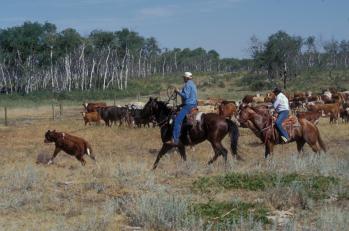
In Saskatchewan, a large portion of the land has been classified as protected lands. Some of these lands are designated as national and provincial parks, others are organized as community pastures. In fact, both federal and provincial governments have established such pastures to promote environmental and agricultural sustainability, in addition to provide grazing and breeding opportunities to agricultural producers. In 2001, there were sixty federal and fifty-six provincial community pastures in Saskatchewan (see Figure CP-1). They occupied 2.57 million acres (1.04 million hectares) of land, most of which is under native pastures. These lands are used primarily for grazing cattle. In fact, federal community pastures have served 2,540 producers with 73,000 cattle and 72,000 calves, per annum, on average. Similarly, on provincial community pastures 2,500 producers had 68,000 cattle and 53,000 calves during the summer grazing period. In addition, producers also pasture ewes, horses and colts on these facilities.
These community pastures create a number of benefits to producers. The cattle brought by producers receive professional herd management, through the expertise of experienced pasture managers and riders. These staff members have access to the latest information on livestock research and technology. Herd health related issues are dealt with quickly and in a professional manner. For small producers, these pastures provide a vehicle for enjoying economies of size without having to incur a large capital investment. Through releasing producers’ time for managing their cattle herd, this program also helps diversify farm operations, particularly for the small-sized operations.
Community pastures provide major benefits. Although benefits to producers, as noted above, have long been recognized, other benefits occurring to society at large have not been. In addition, various levels of the governments also benefit from such activities. Community pastures are protected areas and economic activities are regulated to the point that environmental benefits are not compromised. These provide pristine environment on a large contiguous tract of land. This enables the federal government to fulfill the commitment made under international treaties related to protected areas and biodiversity. Community pastures, being a natural (or semi-natural) ecosystem, are multifunctional in nature. This multi-functionality is present through provision of ecological functions, such as life-support functions, economic functions leading to many commercial activities, and social functions including information through scientific research and educational roles, and through meeting spiritual needs of the society. A recent study identified and estimated value for some of the above functions of the community pastures. Five categories of social benefits were identified: pasture-use related activities; provision of social goods; improving economic development of local and surrounding areas; provision of ecosystem functions; and protection of a natural and social resource base. In addition, pursuit of various commercial activities has been permitted on these community pastures, making them a source of revenue to the federal government.
The pasture-use related activities included soil conservation, conversion of land use from cropland to grazing land, and improvement in the health of animals. On the issue of health improvement for cattle grazed on community pastures, it was concluded that such benefits are not significant. This was based on interviews of federal community pasture managers, and patrons of such pastures.
Total economic benefits of community pastures were estimated to be $2,248 per 100 acres or almost $22 per acre (Table CP-1). Of these, almost half are in terms of private benefits—received for grazing cattle and other animals, and for breeding services. These benefits were in the neighborhood of $11 per acre. A portion of total benefits also accrue to the governments, either through direct revenues generated by other activities on these pastures, or through reduced amount spent on subsidies to producers.
Society benefits from community pastures in several ways. Soil conservation can reduce many social costs, and therefore preserves a valuable resource to society. Many members of society use these community pastures for outdoor recreation and wildlife related recreational activities. Since they are under better management, community pastures can sequester more soil carbon; this becomes a valuable resource, particularly in the context of climate change. In total, social benefits add up to $982 per 100 acres. Thus, community pastures are a valuable resource both in terms of providing benefits for grazing and breeding for producers, but also in terms of bringing benefits to society at large through creating many streams of direct and indirect benefits.
The existence of private, social and fiscal benefits from community pastures has a number of important implications. First and foremost is the implication for establishing user fees for private benefits. If a portion of the total benefits from a natural ecosystem (such as the community pastures) is received by society at large, it would be unfair to charge all costs to the private users only. The level of social and fiscal benefits should be taken into account in estimating user fees for grazing and breeding. A second implication of these results is for privatization of such resources. In the past suggestions have been made to privatize the breeding and grazing services. If such were to happen, the question of continuation of social benefits from these ecosystems might be in jeopardy. Preservation of large contiguous spaces under these federal and provincial community pastures has an intrinsic value that should not be sacrificed for reducing government expenditures.
S.N. Kulshreshtha